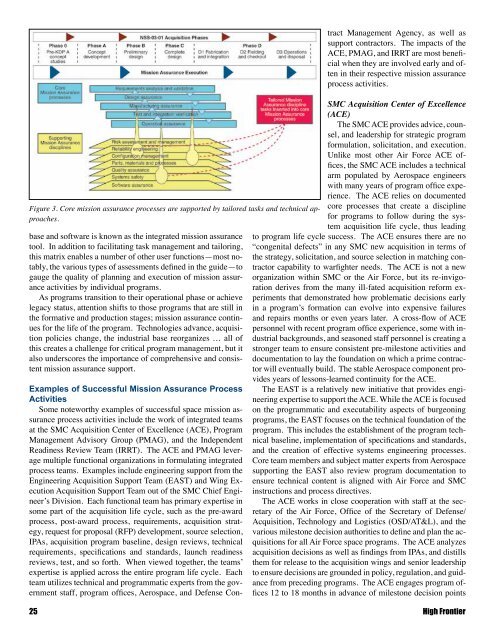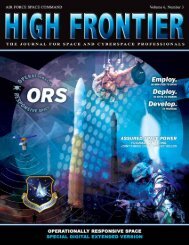Space Acquisition - Air Force Space Command
Space Acquisition - Air Force Space Command
Space Acquisition - Air Force Space Command
You also want an ePaper? Increase the reach of your titles
YUMPU automatically turns print PDFs into web optimized ePapers that Google loves.
Figure 3. Core mission assurance processes are supported by tailored tasks and technical approaches.<br />
base and software is known as the integrated mission assurance<br />
tool. In addition to facilitating task management and tailoring,<br />
this matrix enables a number of other user functions—most notably,<br />
the various types of assessments defined in the guide—to<br />
gauge the quality of planning and execution of mission assurance<br />
activities by individual programs.<br />
As programs transition to their operational phase or achieve<br />
legacy status, attention shifts to those programs that are still in<br />
the formative and production stages; mission assurance continues<br />
for the life of the program. Technologies advance, acquisition<br />
policies change, the industrial base reorganizes … all of<br />
this creates a challenge for critical program management, but it<br />
also underscores the importance of comprehensive and consistent<br />
mission assurance support.<br />
Examples of Successful Mission Assurance Process<br />
Activities<br />
Some noteworthy examples of successful space mission assurance<br />
process activities include the work of integrated teams<br />
at the SMC <strong>Acquisition</strong> Center of Excellence (ACE), Program<br />
Management Advisory Group (PMAG), and the Independent<br />
Readiness Review Team (IRRT). The ACE and PMAG leverage<br />
multiple functional organizations in formulating integrated<br />
process teams. Examples include engineering support from the<br />
Engineering <strong>Acquisition</strong> Support Team (EAST) and Wing Execution<br />
<strong>Acquisition</strong> Support Team out of the SMC Chief Engineer’s<br />
Division. Each functional team has primary expertise in<br />
some part of the acquisition life cycle, such as the pre-award<br />
process, post-award process, requirements, acquisition strategy,<br />
request for proposal (RFP) development, source selection,<br />
IPAs, acquisition program baseline, design reviews, technical<br />
requirements, specifications and standards, launch readiness<br />
reviews, test, and so forth. When viewed together, the teams’<br />
expertise is applied across the entire program life cycle. Each<br />
team utilizes technical and programmatic experts from the government<br />
staff, program offices, Aerospace, and Defense Contract<br />
Management Agency, as well as<br />
support contractors. The impacts of the<br />
ACE, PMAG, and IRRT are most beneficial<br />
when they are involved early and often<br />
in their respective mission assurance<br />
process activities.<br />
SMC <strong>Acquisition</strong> Center of Excellence<br />
(ACE)<br />
The SMC ACE provides advice, counsel,<br />
and leadership for strategic program<br />
formulation, solicitation, and execution.<br />
Unlike most other <strong>Air</strong> <strong>Force</strong> ACE offices,<br />
the SMC ACE includes a technical<br />
arm populated by Aerospace engineers<br />
with many years of program office experience.<br />
The ACE relies on documented<br />
core processes that create a discipline<br />
for programs to follow during the system<br />
acquisition life cycle, thus leading<br />
to program life cycle success. The ACE ensures there are no<br />
“congenital defects” in any SMC new acquisition in terms of<br />
the strategy, solicitation, and source selection in matching contractor<br />
capability to warfighter needs. The ACE is not a new<br />
organization within SMC or the <strong>Air</strong> <strong>Force</strong>, but its re-invigoration<br />
derives from the many ill-fated acquisition reform experiments<br />
that demonstrated how problematic decisions early<br />
in a program’s formation can evolve into expensive failures<br />
and repairs months or even years later. A cross-flow of ACE<br />
personnel with recent program office experience, some with industrial<br />
backgrounds, and seasoned staff personnel is creating a<br />
stronger team to ensure consistent pre-milestone activities and<br />
documentation to lay the foundation on which a prime contractor<br />
will eventually build. The stable Aerospace component provides<br />
years of lessons-learned continuity for the ACE.<br />
The EAST is a relatively new initiative that provides engineering<br />
expertise to support the ACE. While the ACE is focused<br />
on the programmatic and executability aspects of burgeoning<br />
programs, the EAST focuses on the technical foundation of the<br />
program. This includes the establishment of the program technical<br />
baseline, implementation of specifications and standards,<br />
and the creation of effective systems engineering processes.<br />
Core team members and subject matter experts from Aerospace<br />
supporting the EAST also review program documentation to<br />
ensure technical content is aligned with <strong>Air</strong> <strong>Force</strong> and SMC<br />
instructions and process directives.<br />
The ACE works in close cooperation with staff at the secretary<br />
of the <strong>Air</strong> <strong>Force</strong>, Office of the Secretary of Defense/<br />
<strong>Acquisition</strong>, Technology and Logistics (OSD/AT&L), and the<br />
various milestone decision authorities to define and plan the acquisitions<br />
for all <strong>Air</strong> <strong>Force</strong> space programs. The ACE analyzes<br />
acquisition decisions as well as findings from IPAs, and distills<br />
them for release to the acquisition wings and senior leadership<br />
to ensure decisions are grounded in policy, regulation, and guidance<br />
from preceding programs. The ACE engages program offices<br />
12 to 18 months in advance of milestone decision points<br />
25 High Frontier











